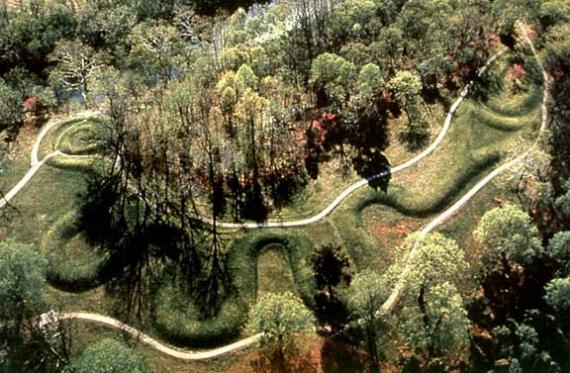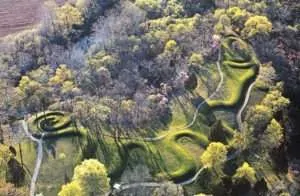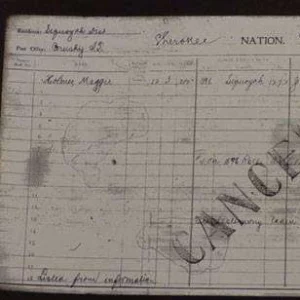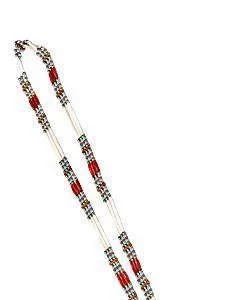The Great Serpent Mound
By Nancy Eling
Over a thousand years ago a group of people we know as the “Mound Builders” constructed a spectacular monument in what is now SW Ohio. Using only the most primitive of tools, these Ancient People built this atop a butte in the valley of Brush Creek near Peebles, Ohio in Adams County.
What is it?
The consensus is that this earthen formation is a snake, although there have been several theories as to the nature of the “head” of the snake. It has been suggested that it represents a snake with its mouth open wide about to swallow an egg or a frog. Another theory, and possibly the most likely, states that it is the abnormally large eye of the snake. There was once an altar of burned stones in its center. If seen from above, a fire built there would have given the impression of an immense glowing eye.
Who built the Serpent?
Some early white settlers believed that the builders of the mounds were ancient peoples from Europe, Africa or the Near East. One theory postulated that the Mound Builders were actually the Lost Tribe of Israel. It has even been attributed to the mythical civilizations of Mu and Atlantis.
An excavation conducted on the Great Serpent in 1996 has revealed that it was most likely built by the people of the “Fort Ancient” Culture, a Mississippian American Indian group that lived in Ohio (A.D. 900-1600). Carbon dating of two samples of wood charcoal excavated from a previously undisturbed section of the Serpent, has revealed its probable construction date of ca. A.D. 1070. The remains of a Fort Ancient village lie about 100 yards south of the mound thus adding further evidence that the serpent was built by the Fort Ancient People.
Construction of the Serpent:
The first step in building the serpent was to level the surface of the butte, preparing it for the monument. The next step was to delineate the outline of the structure with stones.
Once the outline was completed, the body was formed. Clay, brought up the steep cliff in hand-woven baskets from the river valley below, was piled inside the outline to form the body. Next, basket loads of dark soil were smoothed onto the clay, forming the final surface.
The finished work was about 3 feet high and stretched 1348 feet long from its head to the tip of its coiled tail.
[ad#rectangle]What is the purpose of the Serpent?
The most unusual theory of the purpose of the Great Serpent Mound came from a Reverend Landon West, of Pleasant Hill Ohio, who believed that Serpent Mound was the Garden of Eden of the Bible. He believed that it was either made by God Himself, or by man inspired by God via this Biblical phrase:
Job 16:13: “By His spirit He hath garnished the heavens; His hand hath formed the crooked serpent.”
No one today knows why the “Mound Builders” chose to construct a gigantic serpent which could only be fully appreciated from the sky. The purpose of the great serpent was lost when this ancient culture disappeared nearly a thousand years ago, but there were many theories as to its purpose.
It has been theorized that the Serpent is aligned to the summer solstice sunrise or that it was a religious center for the ancient people or that it commemorated the passing of Halley’s Comet in 1066 A.D. It has even been thought that memorializes an eclipse of the sun.
Whatever may be the reason; we now can enjoy this massive snake effigy lying atop the butte as if warming itself in the sunlight and admire the amazing engineering and intelligence of the Fort Ancient Indians.
[ad#rectangle]References:
The Kanawha Valley and its Prehistoric People by Dr. Robert F. Maslowski.
Ohio History, the Scholarly Journal of the Ohio Historical Society, Volume 10, page 225: “Ohio, the site of the Garden of Eden The Serpent Mound, The Home of Adam and Eve.”
Serpent Mound Adams County, Ohio By E. O. Randall, page 93
Archaeology Newsbriefs Vol 49, number 6, NOV/Dec 1996, Re-dating Serpent Mound, by Jessica E. Saraeni.
Last Updated on August 14, 2016 by Paul G






Verlene Veldkamp
says:Your writing is very motivational and you really took command of the subject. This article is a must read. It was a pleasure to read this article I am look forward to your future articles.